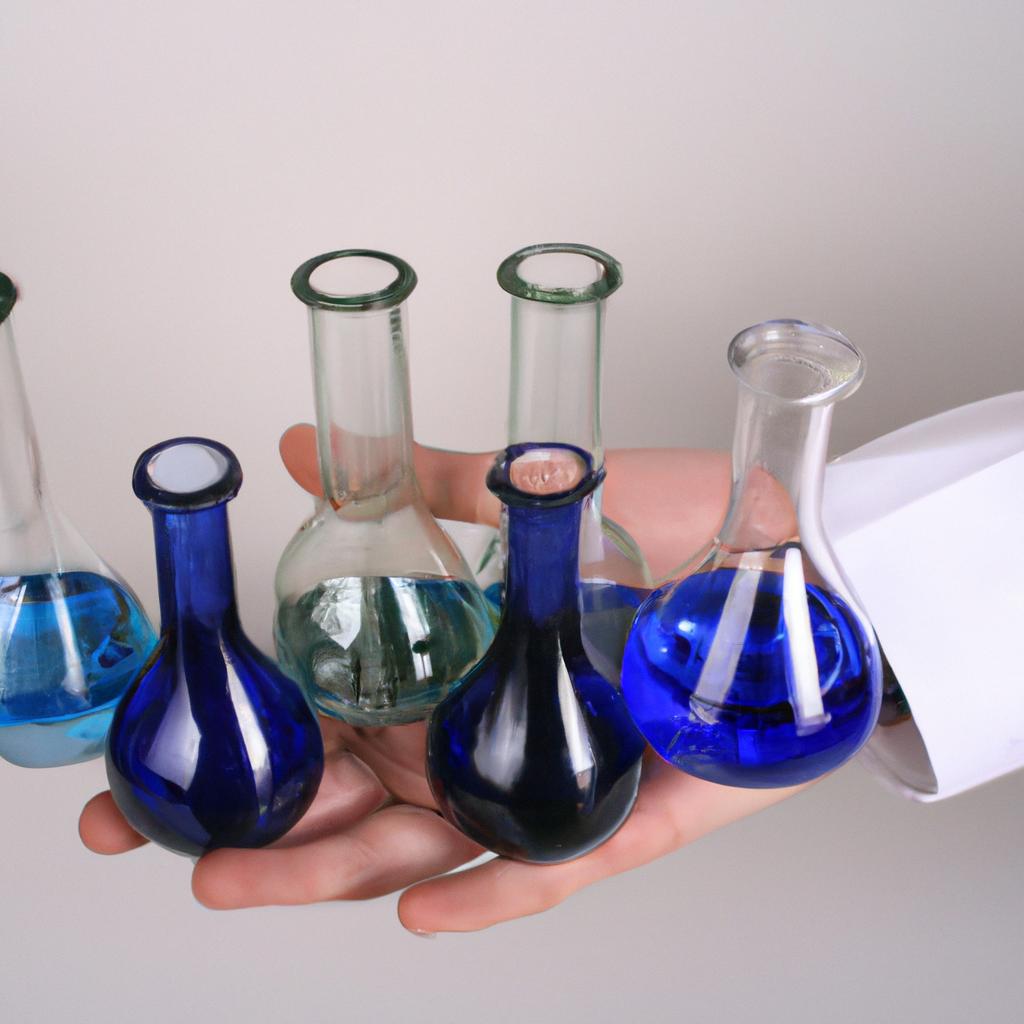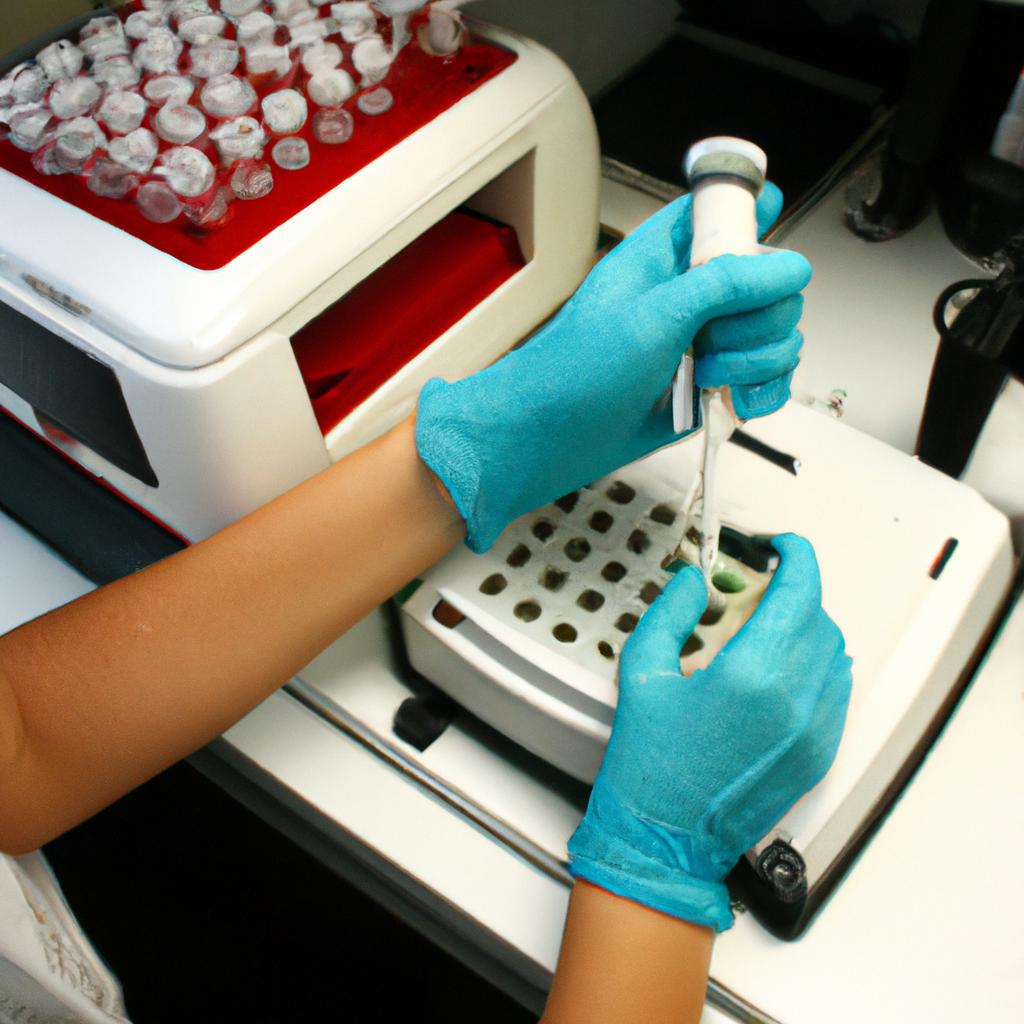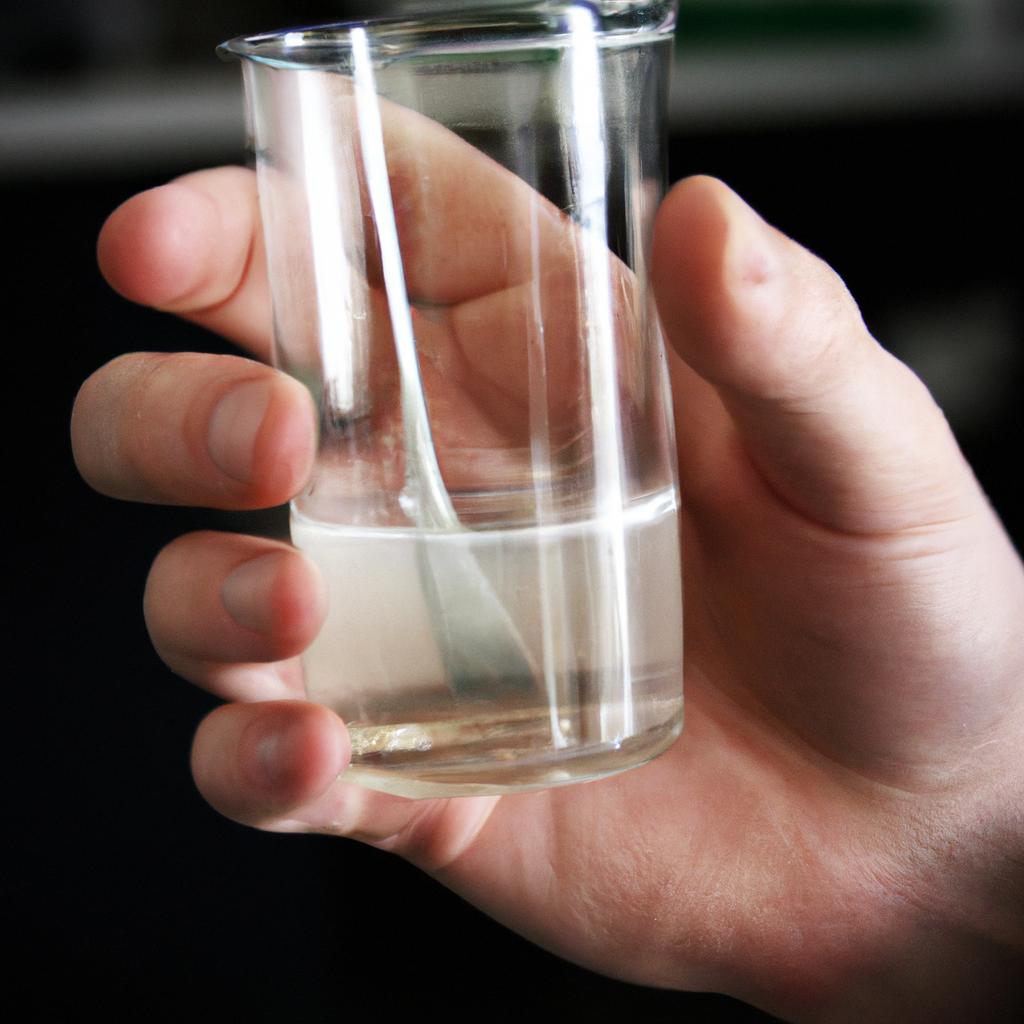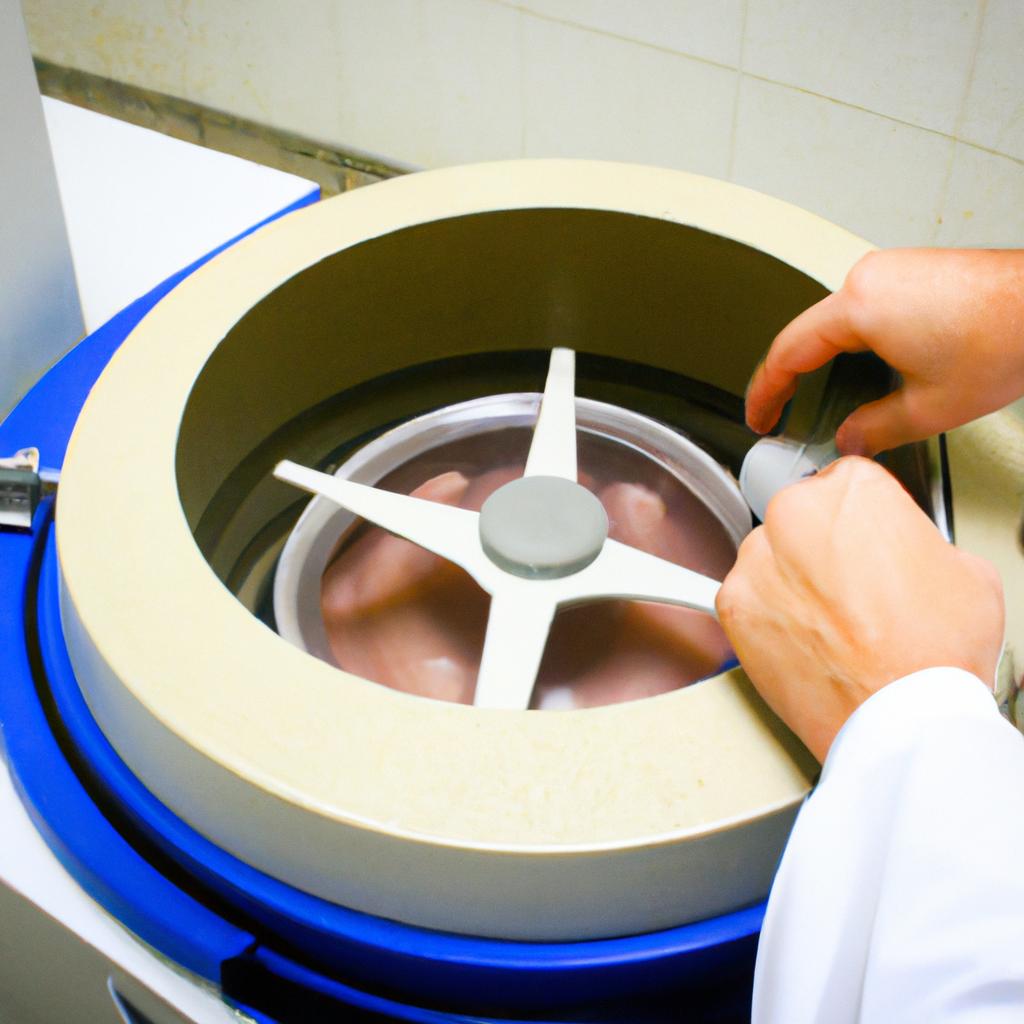Flasks are a fundamental component of laboratory equipment, serving as essential vessels for the containment and manipulation of various substances. With their versatile designs and functionality, flasks play a crucial role in scientific research, allowing scientists to conduct experiments and carry out measurements with precision and accuracy. For instance, imagine a scenario where researchers aim to investigate the reaction kinetics of a chemical compound. In this hypothetical case study, flasks would be utilized to mix the reactants together while maintaining a controlled environment, enabling meticulous observation and analysis.
In an academic context, flasks are often categorized based on their specific applications and design features. Erlenmeyer flasks, for example, possess a conical shape that promotes efficient mixing due to increased surface area compared to flat-bottomed containers. This design is particularly advantageous when conducting titrations or other reactions requiring thorough agitation. On the other hand, volumetric flasks offer precise volume measurement capabilities by providing accurate calibration marks at specific capacities. These specialized types of flasks are commonly used when preparing precise solutions or dilutions in analytical chemistry laboratories.
Furthermore, flasks also come in varying sizes ranging from small-scale options suitable for benchtop experiments to larger volumes required for industrial processes. The materials composing these vessels can vary as well; The materials composing these vessels can vary as well; common options include borosilicate glass, which offers excellent resistance to thermal shock and chemical corrosion, making it suitable for a wide range of applications. Additionally, flasks made from plastic polymers such as polypropylene or polycarbonate are also available, offering advantages such as being lightweight and shatterproof.
Flasks often feature a neck or opening that allows for the addition or removal of substances. This opening can be fitted with various closures such as stoppers, screw caps, or septa depending on the specific needs of the experiment or storage requirements. Some flasks may also have additional features like sidearms or baffles to facilitate specific processes like refluxing or agitation.
Overall, flasks are essential tools in laboratory settings due to their versatility and importance in conducting scientific experiments accurately and efficiently.
What are flasks?
Flasks: Essential Lab Equipment for Instruments and Supplies
Flasks, also known as laboratory flasks or glassware flasks, are indispensable tools used in scientific laboratories for a wide range of purposes. These vessels come in various shapes and sizes, designed to accommodate specific experimental needs. One example is the Erlenmeyer flask, named after its inventor Emil Erlenmeyer, which features a conical shape with a flat bottom and a narrow neck. This design allows for efficient mixing and swirling of liquids without excessive splashing.
To better understand the importance of flasks in laboratory settings, let us consider some key factors that make them essential equipment:
-
Versatility: Flasks can be utilized across different scientific disciplines, including chemistry, biology, and physics. They offer flexibility in conducting experiments such as titrations, distillations, reactions requiring refluxing setups, and cell cultures.
-
Precision: The precise measurement markings on the side of flasks enable scientists to accurately measure volumes of liquid substances. This ensures reproducibility and reliability when performing experiments or preparing solutions.
-
Safety: Flasks often feature tapered ground-glass joints that allow for secure connections with other lab apparatuses like condensers or stoppers. Such fittings prevent leaks or spills during processes involving heat or pressure.
-
Durability: Made from high-quality borosilicate glass material resistant to thermal shock and chemical corrosion, flasks can withstand harsh conditions encountered during experiments. This durability ensures their long-term use while maintaining optimal performance.
Table illustrating different types of flasks:
| Flask Type | Description | Common Use Cases |
|---|---|---|
| Erlenmeyer Flask | Conical shape with a flat bottom and narrow neck; ideal for mixing liquids without splashing | Titration |
| Round-bottom Flask | Spherical body with a single short neck; facilitates even heating and boiling of liquids without splashing | Refluxing reactions |
| Volumetric Flask | Pear-shaped with a long neck and precise volume markings; used for accurate preparation of solutions | Solution preparations |
| Buchner Flask | Flat-bottom flask with side-arm and porous filter plate; employed in vacuum filtration processes to separate solid from liquid samples | Filtration experiments |
Understanding the significance of flasks in laboratory work is vital, as it lays the foundation for exploring the various types available. In the subsequent section, we will delve into different categories of flasks, their specific features, and applications within scientific research. By examining these variations, scientists can select the most suitable type for their experimental requirements.
Types of flasks
Flasks, an essential piece of laboratory equipment, play a crucial role in the field of science. These vessels are specially designed for holding and mixing substances, making them indispensable tools for scientists across various disciplines. To further explore their significance, let’s delve into the different types of flasks commonly used in laboratories.
Consider a hypothetical scenario where a chemist is conducting an experiment to study the reaction between two chemicals. In such cases, the chemist would utilize a round-bottom flask (also known as a boiling flask) as it allows for efficient heating and uniform distribution of heat. With its spherical shape and long neck, this type of flask ensures that vapor condenses back into liquid form instead of escaping during the process.
Types of flasks:
- Erlenmeyer Flask: This conical-shaped flask with a narrow neck is widely used due to its versatility. It can be easily swirled without any risk of spillage, making it suitable for mixing liquids or suspensions.
- Florence Flask: Recognized by its bulbous bottom and long neck, this flask is primarily employed when heating substances evenly over a flame or hot plate.
- Volumetric Flask: Precise measurement is vital in scientific experiments, which is why volumetric flasks come into play. They have highly accurate volume markings etched on their necks, ensuring precise dilution or preparation of solutions.
- Filtering Flask: As the name suggests, this specialized flask incorporates sidearms to facilitate filtration processes by connecting to vacuum apparatuses.
To better visualize these different types of flasks:
| Flasks | Shape | Common Uses |
|---|---|---|
| Round-bottom | Spherical | Efficient heating |
| Erlenmeyer | Conical | Mixing liquids |
| Florence | Bulbous bottom | Evenly heating substances |
| Volumetric | Narrow neck | Precise measurement |
| Filtering | Incorporates sidearms | Facilitating filtration |
By understanding the unique properties and applications of each flask, scientists can select the most suitable option for their specific experiments. Whether it’s a round-bottom flask to ensure efficient heating or an Erlenmeyer flask for mixing liquids without spillage, these vessels are indispensable tools in any laboratory setting.
Moving forward, let’s explore common uses of flasks in the lab and how they contribute to scientific advancements.
Common uses of flasks in the lab
Types of flasks are crucial for various laboratory processes, providing scientists with the necessary tools to conduct experiments and handle specific substances. In this section, we will explore the common uses of flasks in the lab, highlighting their versatility and importance.
Imagine a scenario where researchers need to carry out a chemical reaction that requires heating under controlled conditions. A round-bottom flask would be an ideal choice due to its ability to evenly distribute heat while maintaining constant temperature throughout the process. This type of flask is commonly used in distillation setups or when conducting reactions involving refluxing or evaporation.
Flasks find application across multiple scientific disciplines and serve diverse purposes:
- Mixing and storing solutions: Flasks allow scientists to mix different liquids together efficiently, ensuring thorough mixing without any spillage.
- Culturing microorganisms: Erlenmeyer flasks are often employed for microbial culture growth, enabling researchers to provide an optimum environment for microbe proliferation.
- Measuring volumes accurately: Volumetric flasks have precise volume markings on their necks, making them suitable for preparing accurate standard solutions or dilutions.
- Collecting gases during experiments: Gas collection bottles facilitate safe storage and measurement of gaseous products generated during chemical reactions.
To further illustrate the significance of flasks in laboratories, consider the following table showcasing some common types of flasks along with their typical uses:
| Flask Type | Common Uses |
|---|---|
| Round-bottom | Distillation, refluxing, evaporation |
| Erlenmeyer | Culturing bacteria, general mixing |
| Volumetric | Preparing standard solutions |
| Gas Collection | Collecting gas samples during experiments |
The aforementioned examples highlight how versatile and essential flasks are within a laboratory setting. Their wide range of applications demonstrates why they remain indispensable instruments for scientists across various fields. Understanding the purpose behind each type of flask allows researchers to make informed decisions when choosing the right apparatus for their specific needs.
In the subsequent section, we will delve into considerations and factors to keep in mind while selecting an appropriate flask for your experiments. By understanding these essential criteria, you can ensure optimal results and increased efficiency in your scientific endeavors.
How to choose the right flask for your needs
Understanding the common uses of flasks in the lab allows us to delve into the important task of selecting the right flask for specific experimental requirements. Let’s explore some key factors to consider when choosing a flask.
One example that highlights the significance of selecting the appropriate flask is an experiment involving heat-sensitive chemicals. In this case, using a round-bottom flask made of borosilicate glass would be ideal due to its excellent thermal resistance and ability to withstand high temperatures without cracking or shattering. This example emphasizes how crucial it is to choose a flask that can handle the demands of your experiments.
When selecting a flask, keep in mind these essential considerations:
-
Material Composition:
- Glass flasks are suitable for most applications and offer excellent chemical resistance.
- Plastic flasks provide durability but may not be compatible with certain solvents or extreme temperature conditions.
- Metal flasks have higher thermal conductivity but are susceptible to corrosion by certain substances.
-
Volume Capacity:
- Consider the required volume range for your experiments before deciding on a flask size.
- Ensure that there is sufficient headspace within the container to accommodate any potential expansion during heating or cooling processes.
-
Shape and Design:
- Round-bottom flasks are commonly used for distillation, refluxing, or heating due to their even distribution of heat and ease of swirling liquids.
- Erlenmeyer flasks with conical bottoms are versatile and suitable for various purposes such as titration, mixing solutions, or growing cultures.
To further illustrate these considerations, let’s take a look at a comparison table showcasing different types of flasks along with their advantages and limitations:
| Flask Type | Advantages | Limitations |
|---|---|---|
| Round-bottom | Excellent heat distribution | Challenging to clean due to narrow neck |
| Erlenmeyer | Versatile and suitable for various purposes | Less heat distribution compared to round-bottom flasks |
| Flat-bottom | Stable on surfaces | Limited capacity due to flat shape |
| Filtering flask | Designed for vacuum filtration | Not suitable for heating or direct flame exposure |
By carefully considering these factors, you can ensure that the chosen flask aligns with your experimental requirements, maximizing efficiency and accuracy in your lab work.
Transition into subsequent section about proper care and maintenance of flasks: In order to prolong the lifespan of your flasks and maintain their functionality, it is essential to implement proper care practices. Let’s explore some guidelines for ensuring the longevity and effectiveness of your laboratory equipment.
Proper care and maintenance of flasks
Imagine you are a chemist working in a research laboratory, tasked with finding the perfect flask for your experiment. You carefully consider various factors such as volume requirements, material compatibility, and specific features needed to achieve accurate results. Choosing the right flask is crucial as it directly impacts the success of your experiments and ensures reliable data.
When selecting a flask, there are several key considerations to keep in mind:
-
Volume Capacity: Determine the required volume capacity based on the amount of substance or solution you need to contain. Consider both minimum and maximum volumes to ensure flexibility throughout your experimental process.
-
Material Compatibility: Assess the chemical properties of substances that will come into contact with the flask. Different materials may react differently with certain chemicals, so choose a flask made from a compatible material like borosilicate glass, which offers excellent resistance to heat and chemicals.
-
Flask Type: Decide on the appropriate type of flask based on your experiment’s needs. Common types include round-bottom flasks (ideal for heating liquids), Erlenmeyer flasks (convenient for mixing solutions), and volumetric flasks (used when precise measurements are necessary).
-
Additional Features: Consider any additional features that might enhance your experimental setup. For example, some flasks have ground glass joints for secure connections with other apparatus, while others have graduations for easy measurement readings.
By considering these factors during the selection process, you can optimize your experiments’ efficiency and accuracy.
To further illustrate this point, let’s take an example scenario:
A chemist conducting titration experiments requires a flask capable of holding precisely 100 mL of solution. They must also account for potential reactions between their acidic solution and common laboratory glassware materials like soda-lime glass.
After careful consideration, they select an Erlenmeyer flask made from borosilicate glass due to its high thermal shock resistance and chemical compatibility. The flask’s wide base ensures stability during titration, while the narrow neck minimizes evaporation and spillage.
Remember to consult literature resources, seek guidance from experienced colleagues or lab technicians when in doubt about selecting the most suitable flask for your specific experiment.
Now that you understand how to choose the right flask, it is essential to learn proper care and maintenance techniques to ensure their longevity and reliability.
Understanding the importance of choosing an appropriate flask leads us to consider another crucial aspect – ensuring safety during experiments. Let’s now delve into important safety considerations when using flasks.
Important safety considerations when using flasks
Section H2: Proper care and maintenance of flasks (Continued)
By adhering to these guidelines, researchers can ensure a safe working environment and protect both themselves and their experiments from potential hazards.
Important Safety Considerations:
-
Appropriate Protective Measures:
- Always wear personal protective equipment (PPE), such as gloves and safety glasses, while handling or manipulating flasks.
- Utilize fume hoods or well-ventilated areas when working with volatile substances that may produce harmful vapors.
-
Correct Handling Techniques:
- Avoid sudden temperature changes by allowing glass flasks to reach room temperature before introducing hot liquids or subjecting them to extreme cold.
- When transporting or moving a flask containing hazardous materials, securely hold it near its base to prevent accidental spills or breakage.
-
Effective Cleaning Procedures:
- Thoroughly clean flasks after each use to remove any residual chemicals, contaminants, or biological agents that might compromise subsequent experiments.
- Use appropriate cleaning solutions, following established protocols for effective decontamination without causing damage to the flask’s surface.
-
Safe Storage Practices:
- Store empty flasks separately from those containing potentially hazardous substances to reduce the risk of cross-contamination.
- Clearly label all storage containers with relevant information regarding the contents, date of preparation, and any associated risks.
Case Study Example: Imagine a research laboratory where two scientists are conducting an experiment involving highly reactive chemicals inside separate fume hoods. One scientist strictly follows the recommended safety measures mentioned earlier, including wearing PPE and utilizing proper ventilation. However, disregarding safety precautions entirely, the other scientist fails to do so. As a result, they unknowingly expose themselves to toxic fumes and cause an accidental spill due to improper handling. This case study emphasizes the criticality of adhering to safety protocols when working with flasks.
Table: Common Hazards Associated with Flask Handling
| Hazard | Potential Consequences | Preventive Measures |
|---|---|---|
| Chemical spills | Skin burns, inhalation, | Proper PPE |
| contamination | Utilize fume hoods | |
| Glass breakage | Cuts and injuries | Securely hold at base |
| Biological contaminants | Infection or biohazardous | Thorough cleaning |
| exposure | Use appropriate agents |
- Ensuring personal safety through proper protective measures.
- Implementing correct handling techniques to prevent accidents.
- Following effective cleaning procedures for decontamination.
- Practicing safe storage practices to minimize risks.
By incorporating these important safety considerations into their laboratory routines, researchers can mitigate potential hazards associated with flask usage. Prioritizing safety not only protects individuals from harm but also safeguards valuable research outcomes and contributes to a productive scientific environment.




